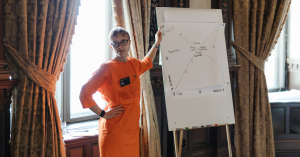“As entrepreneurs, we constantly strive for new challenges; what yesterday seemed like a dream, today is reality, and then we take on a new challenge,” Arijana Koskarova, Co-founder of Creative Hub, tells me. While entrepreneurs may not dream of failure, too, they certainly live it. And good thing they do, because failure is one of the key elements of success, provided one learns from it. Failure teaches one how to succeed.
Three years after launching Creative Hub, with branches in Macedonia and Kosovo, Arijana set her mind on a new project – a yacht app, later named Yacht’n’Go, inspired by her MBA years spent in Monaco. The product envisioned was a full-stack sale and rental app of yachts. Arijana and her team proceeded creating a prototype around this vision. But as you guessed it by now, this was not a success story.
A well known statistic in the startup world is that 90%, more or less, fail. But why? Funding cannot be the one and only reason, after all, the amount of funding pumped into startups is on the rise, macroeconomics-driven derails aside, while the number of startups failing has stayed relatively constant. In CEE, too, there are more startup funding resources now than ever.
The high risk inherited in these projects also partly explains why the percentage of startups failing is so high. Startups often look to disrupt existing markets, playing around with innovative products, some of which meet their need in the market, some of which don’t. And here comes one of the key drivers for startup failure, which we will explore in this first part of the series: poor understanding of the market.
Why you should do your market research religiously
Let’s start with the first thing investors will want to see in your pitch: the stats that show there is a real need for your product in the market.
“The first reason for failure is a lack of enough market need in the region while still focusing only on those markets. Many startups are founded on a great idea or technology, but without a market need for that product or service, the startup is doomed to fail. As a VC investor, it’s important to assess the potential market for a startup’s product or service and determine if there is a real need for it,” Milen Ivanov, Managing Partner at Sofia Angels Ventures, shares.
“For very early stage startups, many with solo founders, two of the most common mistakes are the failure to identify a problem for which potential customers will be willing to pay, and the strive to develop a perfect product or solution before validating the market,” Mihai Guran, CEO, Guran Consulting Global and Vice-President at TechAngels Romania agrees.
To that end, founders will need to conduct thorough market research, which includes a strategic analysis of the competitiveness in the industry:
• Are there players who already hold strong positions in the market, and how defensible are these positions?
• Are there consumer switching costs and how strong is brand loyalty?
“The business world is competitive, and startups need to be able to differentiate themselves from their competitors. If a startup is unable to stand out in the market, they risk being overshadowed by more established companies,” Angel H. Angelov, Managing Partner at Innovation Capital adds.
You will also need to assess which will be your key suppliers and partners in the market, what resources and activities, respectively, you will need from them.
This brings us back to the yacht business story. After working for 2 months on a prototype, and designing an 80 pages project ready-to-go in an app, the team didn’t want to invest more funds prior to testing the product. To do so, Arijana booked a ticket for the Monaco Yacht Show.
“At the yacht exposition I realized that the large brokerage companies in the industry would never partner with a startup. I also realized that the industry is not regulated enough. In other words, I would face more legal backfire than revenue if I decided to launch it at that moment. So, I put the project on pause. Did we invest funds, human capital and hopes? We did. But we could have invested and lost more,” she explains.
So what did she learn from the experience?
“First do market research, even before you start with the UX/UI design. Do an idea research. Validate it. Then start building it.”
After this chapter, the team decided they should leverage their strengths. So two years later, they are in Miami, opening the USA campus of Creative Hub Academy, which aims to help people land careers in tech.
This is part #1 of a series aiming to explore the most common reasons for which startups fail and share their lessons for future entrepreneurs wanting to beat the odds. Stay tuned – and meanwhile, get more resources in our Founder’s School library.








